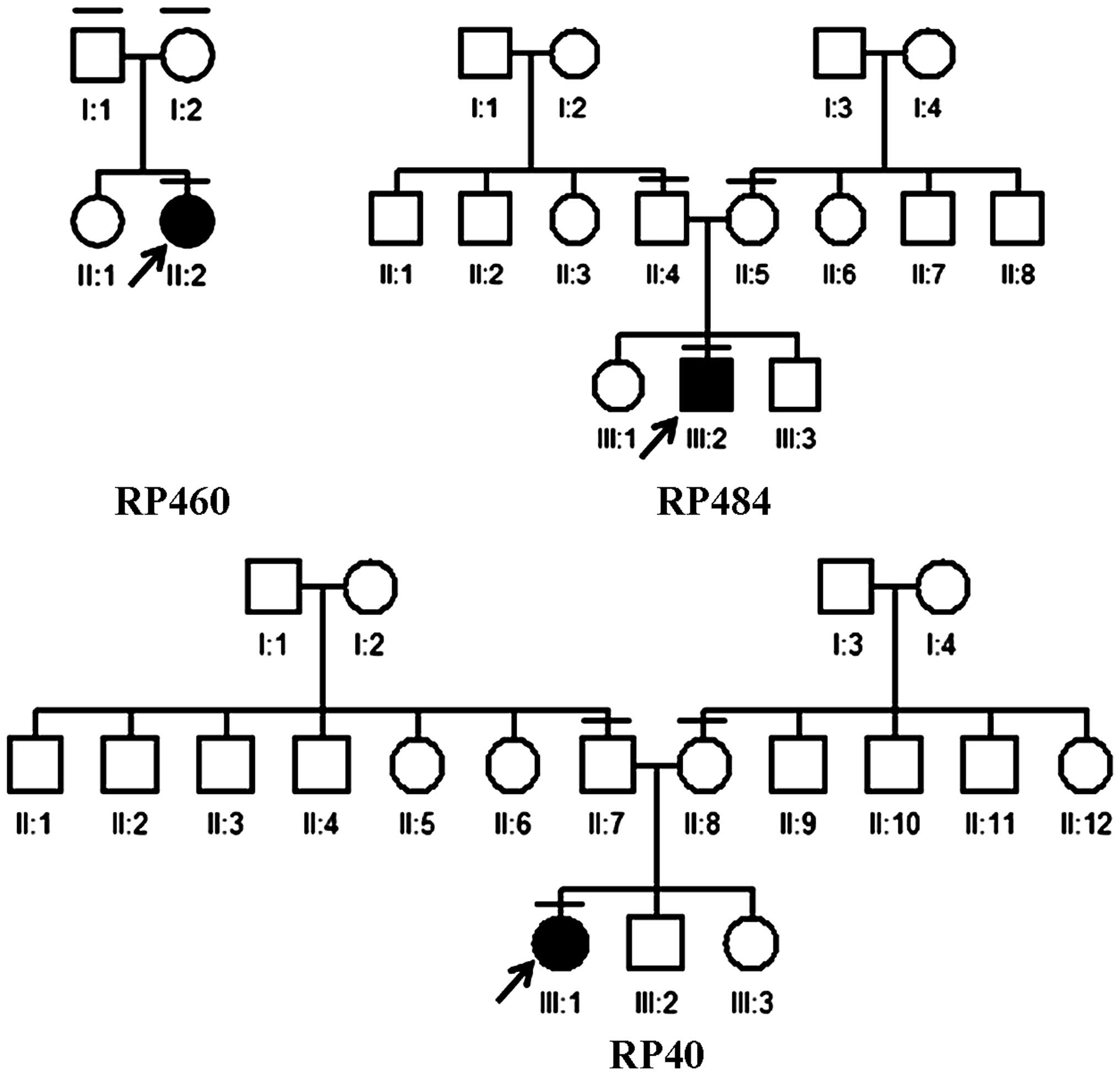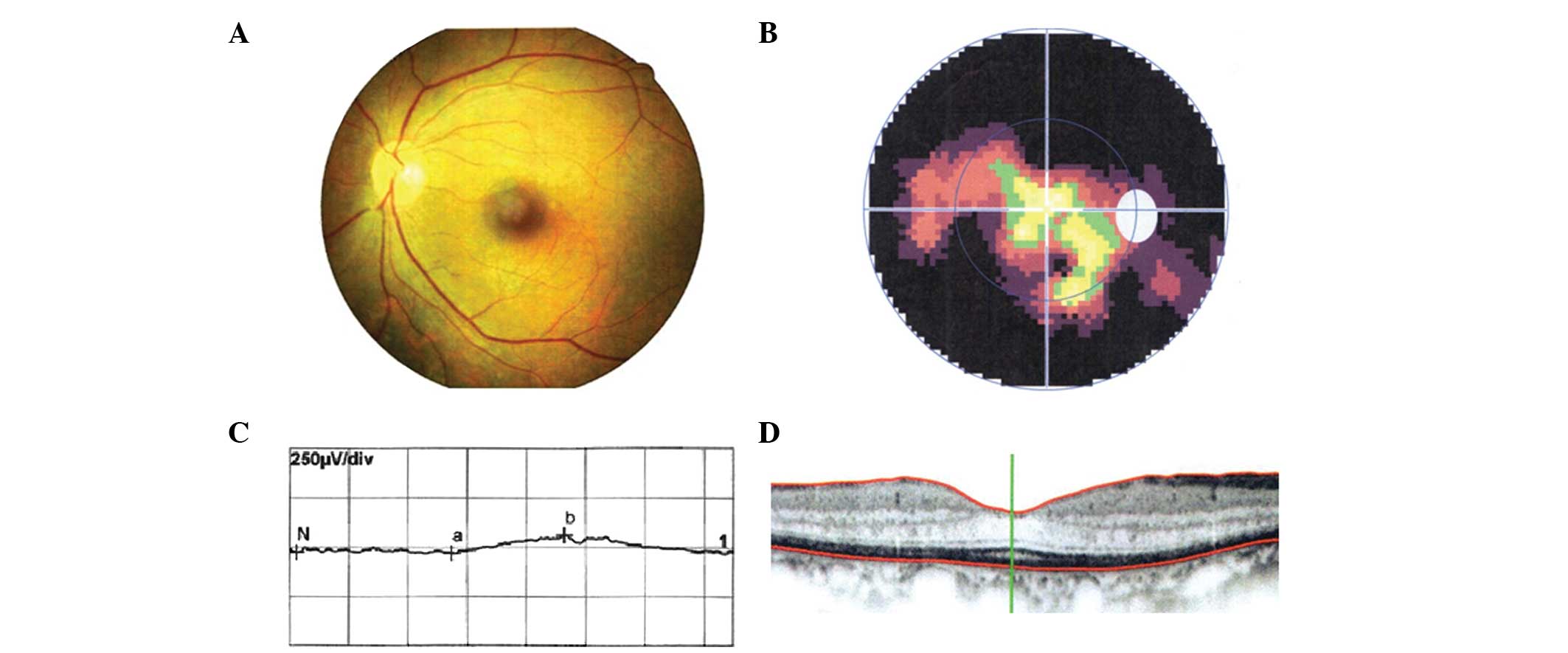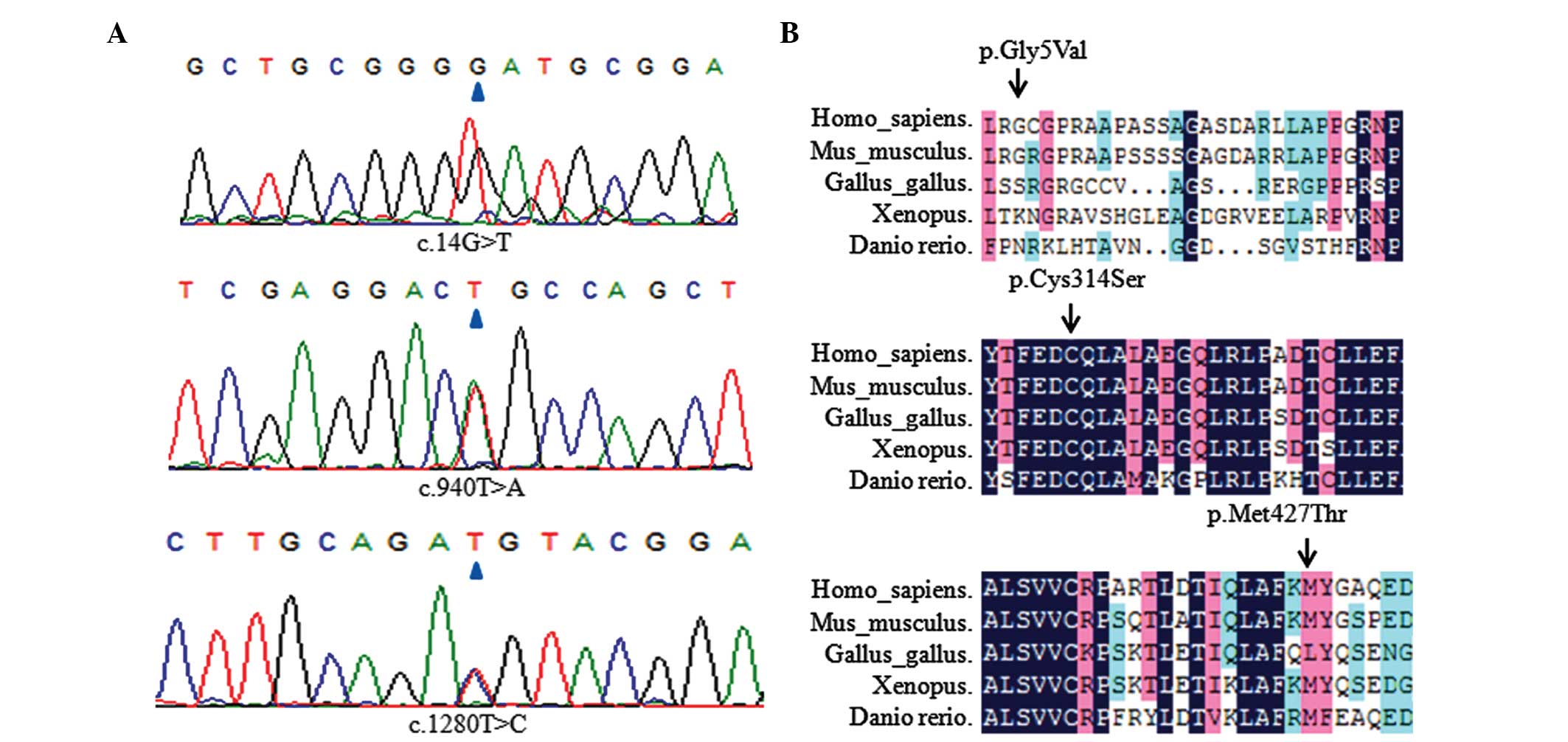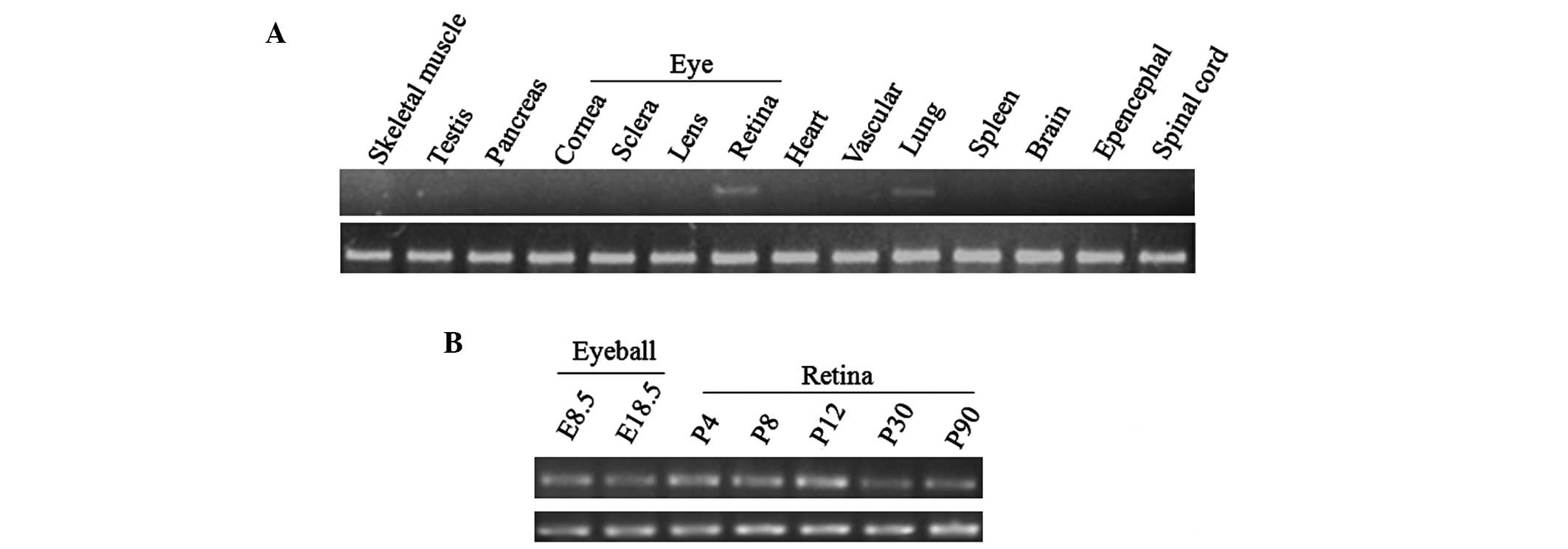Molecular screening of the LPCAT1 gene in patients with retinitis pigmentosa without defined mutations in known retinitis pigmentosa genes
- Authors:
- Published online on: August 10, 2015 https://doi.org/10.3892/mmr.2015.4204
- Pages: 5983-5988
Abstract
Introduction
Retinitis pigmentosa (RP) is a classical inherited eye disorder, which predominantly involves damage to the function and structure of the rod and cone cell photoreceptors and the retina pigment epithelium (1). Individuals affected by RP usually experience night blindness from the early stage of R P, accompanied or followed by the loss of peripheral visual field (1). The typical signs usually present as bone spicule-like pigmentation deposits and a reduced or absent electroretinogram. There are several different genetic defects that could lead to the degeneration of cone or rod cells or to degeneration of the connections between these cells. To date, >70 genes have been identified and seven loci have been mapped for R P. The majority of these genes encode proteins, which are involved in a wide variety of cellular processes, including phototransduction, transcriptional regulation and membrane structure formation. Progress in gene discovery and mutation screening in individuals affected by RP and their families has contributed to personalized treatments for R P, which uses various novel treatment approaches, including stem cells, gene therapy and nutritional supplementation (2–4).
The LPCAT1 gene is located on chromosome 5 and it encodes a 65 kDa protein, which contains three putative transmembrane domains (5). This enzyme, lysophosphatidylcholine acyltransferase 1 (LPCAT1), is involved in lysophosphatidylcholine (LPC) and lipid syntheses, which are important in the formation of biological membranes, endocytosis, signaling and neuroprotection. The outer segment of retinal photoreceptors contains stacks of membranous disks, which are filled with opsin, a light-absorbing protein in the visual transduction process (6). The loss of phosphatidylcholine (PC) can lead to the disruption of membrane structure and homeostasis maintenance, which can ultimately contribute to photoreceptor cell degeneration (6). In addition, LPCAT1 has been identified to be involved in the non-inflammatory PAF remodeling pathway and in the progression of cancer, including like colorectal and prostate cancer (7–9).
A previous study by Friedman et al (6) identified a single nucleotide insertion (c.420_421insG) in exon 3 of the LPCAT1 gene in rd11 mice, and identified a seven-nucleotide deletion (c.14-20delGCCGCGG) in exon 1 in mice of the B6-JR2845 strain, which leads to premature truncation of the LPCAT1 protein. These two mouse strains present with typical symptoms of R P. Dai et al demonstrated that retinal function and structure can be rescued in rd11 mice using gene replacement therapy (10). This further supports the hypothesis that LPCAT1 may be a possible candidate disease-causing gene of RP in humans. However, the specific genetic mutations in LPCAT1, which predispose individuals to RP remain to be elucidated. With the exception of LPCAT1, a number of genes (Table I) have been demonstrated to cause retinal degeneration in animal models, but not in human subjects (11–15).
There are three major patterns of inheritance in R P, including autosomal dominant (ad), autosomal recessive (ar) and X-linked inheritance. Of the total cases of R P, ~30% are adRP, 20% are arRP and 15% are X-linked RP (16). The remaining cases, at least 30%, are isolated cases, the patterns of which are difficult to distinguish as either recessive or dominant inheritance. Since the LPCAT1 mutations, which have been identified in mice are homozygous, the present study hypothesized that the mode of inheritance of this gene is either recessive or sporadic. Therefore, the present study recruited a cohort of patients who were diagnosed with RP and exhibited a either one of these two types of inheritance patterns. In the present study, the LPCAT1 gene was screened in 50 Chinese patients with R P, and mutations in all previously investigated genes were excluded based on a targeted exome-sequencing panel, suggesting the existence of novel causative genes.
Materials and methods
Patient recruitment
The present study was performed in accordance with the Declaration of Helsinki. The study was supported by the Ethics Committee of The Eye Hospital of Wenzhou Medical University (Division of Opthalmic Genetics, Wenzhou, China). Written informed consent was obtained from each patient prior to commencement of the investigation. All the patients were natives of China and the detailed family histories of the patients were collected. The majority of the participants were affected by isolated or simple cases of R P, without any obvious genetic predisposition. The diagnoses of RP were made based on the presence of symptoms, including night blindness and impaired visual acuity, observed typical fundus, reduced peripheral visual field and abnormal optical coherence tomography (OCT) results. The total number of patients enrolled in the present study was 50, which included 24 females and 26 males, aged between 5 and 65 years.
The 50 patients recruited were comprehensively screened for mutations in all the known RP genes through targeted exome sequencing using an Illumina HiSeq 2000 sequencer, as described previously (17). This was performed with the intention of identifying genetic factors that may have predisposed these patients to R P.
DNA extraction
Total genomic DNA was extracted from the peripheral blood (3 ml) using a Tiangen DNA Extraction kit (Tiangen Biotech, Co., Ltd., Beijing, China) according to the manufacturer's instructions. DNA was quantified using a Nanodrop 2000 spectrophotometer (Thermo Fisher Scientific, Waltham, MA, USA).
Gene screening and data analysis
The primers used in polymerase chain reaction (PCR) analysis were designed to detect mutations and polymorphisms in the entire coding region and exon-intron boundaries of the LPCAT1 gene in the patients with R P. The PCR reactions were performed using a 50 µl reaction volume, which contained 100 ng genomic DNA, 2 pmol of each of the primers and 25 µl 2X Taq PCR Master Mix (Biotake, Beijing, China). The PCR process was performed using an ABI Veriti thermocycler (Applied Biosystems Life Technologies, Foster City, CA, USA). With the exception of exon 1, for which the denaturation temperature was set at 98°C, all PCR reactions were performed for 32 cycles with a denaturation temperature set at 95°C for 30 sec, an annealing temperature set 58°C for 30 sec, an extension step at 72°C for 40 sec and a final elongation step at 72°C for 5 min. Sequence analyses were performed using a Mutation Surveyor software (Softgenetics, State College PA, USA) and the suspected variants were assessed using the polymorphism phenotype (PolyPhen-2; http://genetics.bwh.harvard.edu/pph2/) and Mutation Taster (http://www.mutationtaster.org/) tools to predict the pathogenicity. Detailed information on the PCR primers used are listed in Table II.
Gene expression of LPCAT1 in various tissues and the developmental retina
A three-month-old female C57BL/6 mouse was supplied by the Animal Resource Center at Wenzhou Medical University, where it was fed a standard chow diet and kept under standard conditions. Animal care and husbandry followed the Association for Research in Vision and Ophthalmology (ARVO) guidelines (http://www.arvo.org/Journals_and_Publications/Toolkit_for_Biomedical_Researchers_Using_Laboratory_Animals/) and the mouse was sacrificed by cervical dislocation. Mouse total RNA was prepared from various tissues, including whole brain, retina, lens, sclera, cornea, spinal cord, heart, lung, pancreas, testis, epencephal, vascular and skeletal muscle, and spleen. Total RNA was extracted from different tissues of mouse, then cDNA was synthesized using for semi-quantitative PCR. Retinal RNA at various stages of development were also extracted using the Tiangen RNA Extraction kit (Tiangen). A 354 bp fragment of LPCAT1 was generated by reverse transcription using the Tiangen RT-PCR kit (Tiangen) with the following primers: Forward 5′-GACTCGCGAAGGAAGACAGT-3′ and reverse 5′-CATGACACGCCTCACATTGC-3′. The RNA was also used as a template for PCR, using β-actin primers as a control.
Results
Phenotype determination
All patients recruited in the present study were diagnosed with either recessive or sporadic RP (Fig. 1). The ages of disease onset varied substantially, between childhood and late adult life. All patients reported experiencing typical RP signs and symptoms, including night blindness, visual field constriction, visual impairment, bone spicule-like pigmentation, artery attenuation and waxy pallor of the optic nerve head in the fundi. Fig. 2 shows the representative clinical results of patient RP40-III:1, which was from the family RP40.
Mutation screening of LPCAT1
The results obtained from direct sequencing were analyzed, from which three heterozygous missense variants (p.Gly5Val, p.Met427Thr and p.Cys314Ser) and four synonymous variants (c.399G>A, c.645A>C, c.657C>A and c.1365C>T) were identified in the LPCAT1 gene in the patients. Of these variants, two were predicted to be pathogenic, according to the results of the computational prediction performed using PolyPhen-2 and Mutation Taster.
Co-segregation analysis
For the three possible heterozygous missense mutations, their grade of conservation was analyzed and co-segregation analysis was performed in each pedigree (Fig. 3). The three heterozygous mutation sites in the parents of these patients were also screened. The results demonstrated that the mutations were inherited from either the paternal or the maternal allele. Since their parents did not suffer from R P, the heterozygous variants were not considered to predispose an individual to R P. Overall, no definite pathogenic variant was identified in the LPCAT1 gene. In addition, the frequencies of these three single nucleotide polymorphisms were observed to be particularly high (>0.01)in the patients examined (Table III).
Tissue distribution of LPCAT1 in mice
The tissue distribution of LPCAT1 was analyzed using RT-PCR. The highest expression level of LPCAT1 was observed in the retina, followed by the lung and the spinal cord. Other tissues had particularly low expression levels of LPCAT1 (Fig. 4). These results suggested that LPCAT1 may be important in the development and function of the mammalian retina.
Discussion
LPCAT, which is the most important enzyme in membrane biogenesis and surfactant production, converts LPC to PC (6). Based on previous studies on LPCAT1 in mice and the availability of an animal model for human R P, the present study aimed to investigate whether LPCAT1 is involved in the development of RP in a Chinese population (18).
In the present study, a total 50 patients diagnosed with RP were enrolled for investigation. These patients were previously screened for mutations in ~164 retinal-associated genes using established targeted exome sequencing technology. Based on the obtained family histories, the families selected for investigation in the present study were affected by RP exhibiting either recessive or sporadic inheritance patterns. All the coding regions and exon-flanking regions of the LPCAT1 gene were sequenced in the participants and, with the exception of certain synonymous variants, three variants, which resulted in amino acid changes, were identified. However, none of these missense variants were determined as being pathogenic.
The results of the present study indicated that none of the LPCAT1 variants identified were significantly associated with RP in the examined group of Chinese patients. The lack of correlation between the LPCAT1 variants and patients with RP suggested that the possibility of these LPCAT1 genetic variations attributing to the pathogenesis of RP was low. It is possible, however, that pathogenic mutations in this gene may exist outside of the coding exons and flanking intron splice sites. It is also possible that the pathogenic mutations, which occur in LPCAT1, result in a form of retinal degeneration that was absent in the patients included in the present study.
In conclusion, the results of the present study suggested either that mutations in LPCAT1 do not confer a genetic predisposition to R P, or that the incidence is rare in patients with R P. An increase in sample sizes may enable the screening of more patients with RP patients for pathogenic mutations in LPCAT1. In addition, additional genetic investigations in other ethnic populations are required to further elucidate the potential association between LPCAT1 and R P.
Acknowledgments
The authors would like to thank all patients for their participation in the investigation. This study was supported by the National Key Basic Research Program (grant. no. 2013CB967502) to Dr Zi-Bing Jin), the National Natural Science Foundation of China (grant. no. 81371059) to Dr Zi-Bing Jin and the Zhejiang Provincial Natural Science Foundation of China (grant. nos. Y12H12003 and LR13H120001 to Dr Qin-Kang Lu and Dr Zi-Bing Jin, respectively.
References
|
Hartong DT, Berson EL and Dryja TP: Retinitis pigmentosa. Lancet. 368:1795–1809. 2006. View Article : Google Scholar : PubMed/NCBI | |
|
Dryja TP, McGee TL, Hahn LB, Cowley GS, Olsson JE, Reichel E, Sandberg MA and Berson EL: Mutations within the rhodopsin gene in patients with autosomal dominant retinitis pigmentosa. N Engl J Med. 323:1302–1307. 1990. View Article : Google Scholar : PubMed/NCBI | |
|
Daiger SP, Sullivan LS and Bowne SJ: Genes and mutations causing retinitis pigmentosa. Clin Genet. 84:132–141. 2013. View Article : Google Scholar : PubMed/NCBI | |
|
Bessant DA, Ali RR and Bhattacharya SS: Molecular genetics and prospects for therapy of the inherited retinal dystrophies. Curr Opin Genet Dev. 11:307–316. 2001. View Article : Google Scholar : PubMed/NCBI | |
|
Nakanishi H, Shindou H, Hishikawa D, Harayama T, Ogasawara R, Suwabe A, Taguchi R and Shimizu T: Cloning and characterization of mouse lung-type acyl-CoA:Lysophosphatidyl choline acyltransferase 1 (LPCAT1). Expression in alveolar type II cells and possible involvement in surfactant production. J Biol Chem. 281:20140–20147. 2006. View Article : Google Scholar : PubMed/NCBI | |
|
Friedman JS, Chang B, Krauth DS, Lopez I, Waseem NH, Hurd RE, Feathers KL, Branham KE, Shaw M and Thomas GE: Loss of lysophosphatidylcholine acyltransferase 1 leads to photoreceptor degeneration in rd11 mice. Proc Natl Acad Sci USA. 107:15523–15528. 2010. View Article : Google Scholar : PubMed/NCBI | |
|
Harayama T, Shindou H, Ogasawara R, Suwabe A and Shimizu T: Identification of a novel noninfammatory biosynthetic pathway of platelet-activating factor. J Biol Chem. 283:11097–11106. 2008. View Article : Google Scholar : PubMed/NCBI | |
|
Grupp K, Sanader S, Sirma H, Simon R, Koop C, Prien K, Hube-Magg C, Salomon G, Graefen M, Heinzer H, et al: High lysophosphatidylcholine acyltransferase 1 expression independently predicts high risk for biochemical recurrence in prostate cancers. Mol Oncol. 7:1001–1011. 2013. View Article : Google Scholar : PubMed/NCBI | |
|
Xu B, Gao L, Wang L, Tang G, He M, Yu Y, Ni X and Sun Y: Effects of platelet-activating factor and its differential regulation by androgens and steroid hormones in prostate cancers. Br J Cancer. 109:1279–1286. 2013. View Article : Google Scholar : PubMed/NCBI | |
|
Dai X, Han J, Qi Y, Zhang H, Xiang L, Lv J, Li J, Deng WT, Chang B, Hauswirth WW and Pang JJ: AAV-mediated lysophosphatidylcholine acyltransferase 1 (Lpcat1) gene replacement therapy rescues retinal degeneration in rd11 mice. Invest Ophthalmol Vis Sci. 55:1724–1734. 2014. View Article : Google Scholar : PubMed/NCBI | |
|
Schrick JJ, Vogel P, Abuin A, Hampton B and Rice DS: ADP-ribosylation factor-like 3 is involved in kidney and photoreceptor development. Am J Pathol. 168:1288–1298. 2006. View Article : Google Scholar : PubMed/NCBI | |
|
Gerding WM, Schreiber S, Schulte-Middelmann T, de Castro Marques A, Atorf J, Akkad DA, Dekomien G, Kremers J, Dermietzel R, Gal A, et al: Ccdc66 null mutation causes retinal degeneration and dysfunction. Hum Mol Genet. 20:3620–3631. 2011. View Article : Google Scholar : PubMed/NCBI | |
|
Ma C, Papermaster D and Cepko CL: A unique pattern of photoreceptor degeneration in cyclin D1 mutant mice. Proc Natl Acad Sci U S A. 95:9938–9943. 1998. View Article : Google Scholar : PubMed/NCBI | |
|
Alves CH, Sanz AS, Park B, Pellissier LP, Tanimoto N, Beck SC, Huber G, Murtaza M, Richard F, Sridevi Gurubaran I, et al: Loss of CRB2 in the mouse retina mimics human retinitis pigmentosa due to mutations in the CRB1 gene. Hum Mol Genet. 22:35–50. 2013. View Article : Google Scholar | |
|
Vogel P, Gelfman CM, Issa T, Payne BJ, Hansen GM, Read RW, Jones C, Pitcher MR, Ding ZM, DaCasta CM, et al: Nephronophthisis and retinal degeneration in tmem218-/-mice: A novel mouse model for senior-loken syndrome? Vet Pathol. 52:580–595. 2015. View Article : Google Scholar | |
|
Daiger SP, Bowne SJ and Sullivan LS: Perspective on genes and mutations causing retinitis pigmentosa. Arch Ophthalmol. 125:151–158. 2007. View Article : Google Scholar : PubMed/NCBI | |
|
Huang XF, Huang F, Wu KC, Wu J, Chen J, Pang CP, Lu F, Qu J and Jin ZB: Genotype-phenotype correlation and mutation spectrum in a large cohort of patients with inherited retinal dystrophy revealed by next-generation sequencing. Genet Med. 17:271–278. 2015. View Article : Google Scholar | |
|
Dai X, Han J, Qi Y, Zhang H, Xiang L, Lv J, Li J, Deng WT, Chang B, Hauswirth WW and Pang JJ: AAV-mediated lysophosphatidylcholine acyltransferase 1 (Lpcat1) gene replacement therapy rescues retinal degeneration in rd11 mice. Invest Ophthalmol Vis Sci. 55:1724–1734. 2014. View Article : Google Scholar : PubMed/NCBI |













